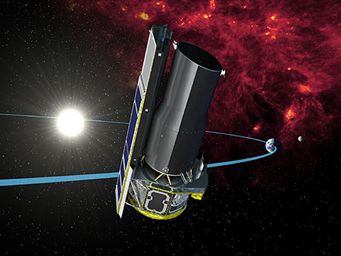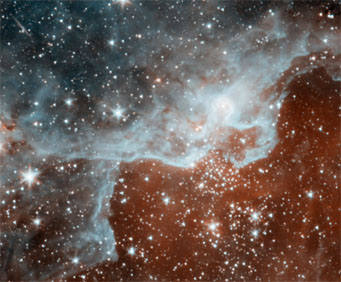What would you do if your eyes suddenly lost the ability to see reds and yellows, leaving you to see the world only as greens and blues?

Launched in August 2003, the Spitzer Space Telescope trails behind Earth in a heliocentric orbit.
NASA / JPL-Caltech
That gives you some idea of how deep-space astronomers are learning to cope with recent changes aboard NASA's Spitzer Space Telescope, which ran out of liquid helium to supercool its detectors last May. Since then the orbiting observatory has gradually warmed, from within a few degrees of absolute zero to 30 K (–406°F).
While still far, far colder than even the most frigid Antarctic winter, the warmer operating temperature has rendered useless two of Spitzer's four detectors: the long-wavelength channel of its imaging photometer and its infrared spectrograph. The loss isn't causing a lot of hand-wringing, though. After all, the liquid helium lasted 5½ years, far longer than expected. Moreover, the European Space Agency's Herschel observatory, launched May 14th, observes much of that lost spectral swath.
Otherwise, the fourth and last of NASA's Great Observatories continues to work well. So on July 27th, Spitzer's handlers kicked off its "warm mission" with a revised agenda for exploring the cosmos. New mission objectives, according to a press release from NASA and the Harvard-Smithsonian Center for Astrophysics, include refining estimates of the Hubble constant (a measure of the universe's expansion rate), searching for primordial galaxies, characterizing several hundred asteroids in Earth's vicinity, and studying the atmospheres of gas-giant planets swept up by NASA's recently launched Kepler spacecraft.

An interstellar cloud in Cygnus known as DR22 is ablaze with new stars, dusty clouds (colored blue), and hot gas (orange). The Spitzer observatory's remaining infrared detectors can see warm interstellar dust that would otherwise be invisible — and see through it to the regions beyond — providing a unique view into star-forming centers like this one. Click here for a larger view.
NASA / JPL / Caltech
Moreover, notes Spitzer astronomer Michelle Thaller (IPAC/Caltech), "The instrument that will still be around — the infrared array camera — is the one that's responsible for most of the gorgeous imagery that you see coming out of Spitzer."
As if to underscore that latter point, today the project released a trio of images recorded at 3.6 and 4.5 microns, relatively short infrared wavelengths sensitive to gas and dust that would appear dark to human eyes but still aglow with warmth.
My take on all this? Looking at the universe through infrared eyes is, well, really cool.
 0
0
Comments
You must be logged in to post a comment.